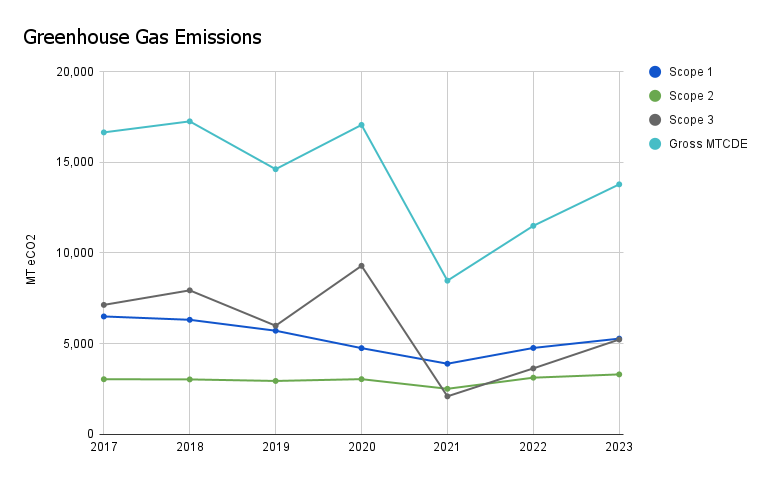GHG Emissions

Many of Humboldt’s operational and business activities generate greenhouse gases (GHG), generally defined as gases that trap heat in the atmosphere and oceans. Anthropogenic GHG are driving global climate change and its associated impacts on social, environmental and economic systems. Humboldt tracks and reports on direct emissions from sources owned and operated by the campus (from combustion of natural gas, propane and fleet fuels), on indirect emissions resulting from the generation of electricity purchased by Humboldt, and on related emissions associated with business travel, commuting, and solid waste. Emissions are measured in metric tons of carbon dioxide equivalent (MTCDE). In 2022-23 Scope 1 natural gas and fuel use comprised 38% of the campus greenhouse gas inventory. Scope 2 Electricity comprised 24%, and Scope 3 (related emissions from commuting, air travel, solid waste and fuel+energy related activities like oil production, refining and fuel transport) comprised 38% of the inventory.
Goals
- Reduce facility carbon emissions to 80 percent below 1990 levels by 2040 in order to achieve carbon neutrality by 2045 in accordance with Statewide mandates (CSU Sustainability Policy).
- Achieve carbon neutrality by 2045 (Climate Action Plan 2.0).
- 10% of all light-duty fleet purchases by CSU campuses shall be zero emissions vehicles (ZEV) in FY 2017-18, increasing by 5% annually through FY 2024-25 to a total of 50% of light duty fleet vehicles purchases (ICSUAM Section 9171).
Status
Humboldt’s Climate Action Plan 2.0 (CAP 2.0), released in 2022, includes 35 strategies to curb the consumption of fossil fuels, procure or generate electricity from renewable resources, sequester carbon, integrate climate action into academics and research, and build resilience to present and future climate change hazards. Overall declines in campus natural gas and electricity consumption, along with fleet fuel efficiency and increasing amounts of purchased electricity from renewable sources, have led to reductions in greenhouse gas emissions over time, even as the campus’ building footprint has increased.
Projects
- Integrate sustainability, carbon neutrality and climate resilience into the campus physical plan - in progress
- Installation of green building technologies, including smart LED lighting, heat pump, and EV charging (Facilities Management) – ongoing
- Fleet vehicle replacements with fuel efficient vehicles (Facilities Management) – ongoing
- Server virtualization and desktop power management systems (Information Technology Services) - ongoing
- Interior and exterior LED lighting retrofits (Facilities Management) – ongoing
- Building HVAC and water heating upgrades and controls (Facilities Management) – ongoing
- Green Workplace Assessment Program (Green Campus) – ongoing
Next Steps
- Implement strategies in the CAP 2.0 to achieve carbon neutrality by 2045 and to build campus resilience to climate change impacts.
- Install 2 MW solar electric system with battery storage.
- Switch or renegotiate power purchase agreement to electricity sourced from 100% renewable energy.
- Conduct regular carbon sequestration inventories of Humboldt forested properties to identify carbon offset potential.
Learn More and Get Involved
- Office of Sustainability’s Climate Action Analyst facilitates programs, projects and initiatives to curb GHG and to build community resilience to climate change impacts.
- Humboldt Advisory Committee on Sustainability, comprised of students, faculty and staff, advises campus leadership on actions the campus can take to reduce GHG and integrate sustainability.
- Associated Students’ Earth Week Every Week Committee plans events and workshops to educate, create community, and foster dialogue around the theme of sustainability, issues of social and environmental justice, human and non-human rights, and healthy lifestyles.